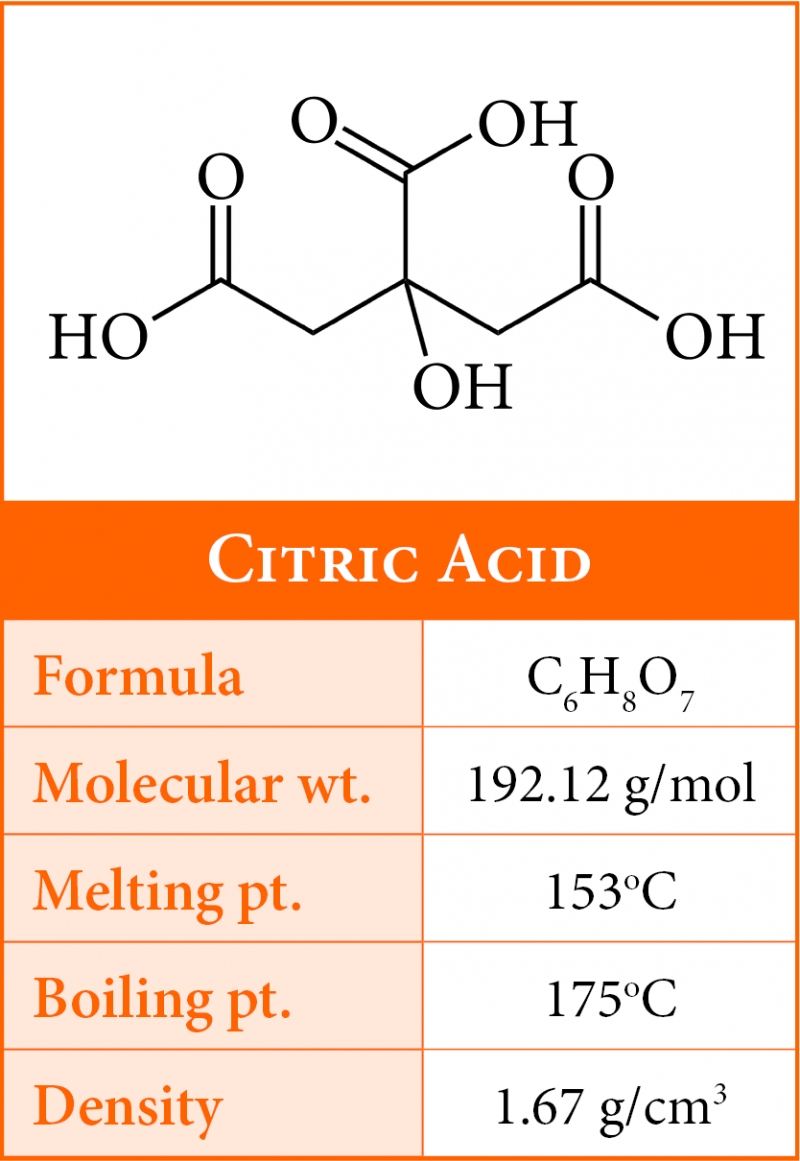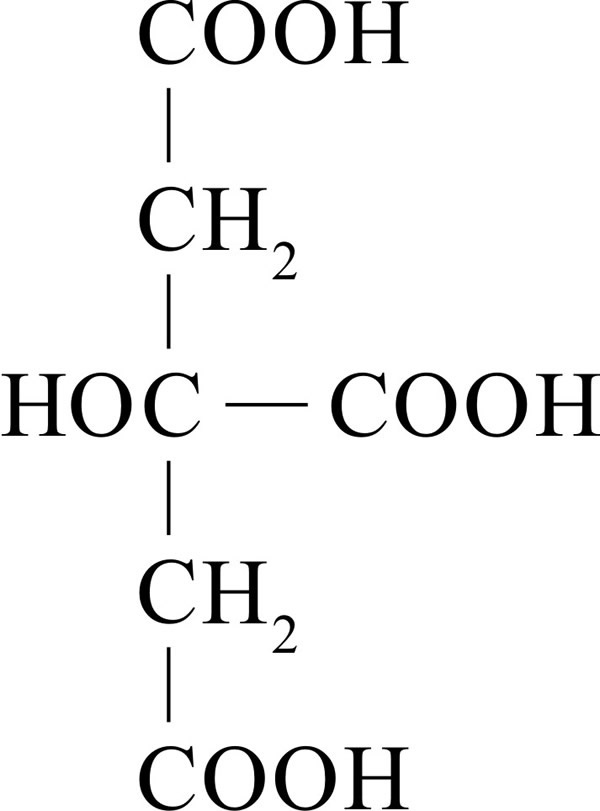Fórmula química Ácido cítrico Molécula Composto químico Química, outros, elemento químico

Citric Acid Rumus Kimia Bit CDN
CITRIC ACID MONOHYDRATE Revisi: 01 Tanggal : 10.03.2018 No. MSDS : 059 2.3 Bahaya lain Tidak ada yang diketahui Bagian 3 - Komposisi dan Informasi Bahan 3.1 Bahan Sinonim : 2-Hydroxypropane-1,2,3-tricarboxylic acid, Hydroxytricarballylic acid, monohydrate. Rumus Kimia : C6H8O7.H2O Berat Molekul : 210.14 g/mol No. CAS : 5949-29-1 No. EC : 201.

3D image of Citric acid skeletal formula molecular chemical structure of C6H8O7 isolated on
Citric acid monohydrate is an organic molecular entity. ChEBI. Citric Acid Monohydrate is a tricarboxylic acid found in citrus fruits. Citric acid is used as an excipient in pharmaceutical preparations due to its antioxidant properties. It maintains stability of active ingredients and is used as a preservative.
Citric Acid Concept Chemical Formula Icon Label, Text Font Vector Illustration Stock Vector
Citric acid is an organic compound with the chemical formula HOC(CO 2 H)(CH 2 CO 2 H) 2. It is a colorless weak organic acid. It occurs naturally in citrus fruits.In biochemistry, it is an intermediate in the citric acid cycle, which occurs in the metabolism of all aerobic organisms.. More than two million tons of citric acid are manufactured every year. It is used widely as an acidifier, as a.

Citric Acid
Citric Acid atau Asam Sitrat dengan rumus kimia C6H8O7 digunakan dalam industri makanan minuman, farmasi, kosmetik, deterjen dsb. Info Bahan Kimia, Kemasan dan Toko Kimia .. Dengan rumus kimia C6H8O7, asam sitrat ditemukan secara alami dalam buah-buahan sitrus seperti jeruk, lemon, dan lime. Keberagaman sifat kimia asam sitrat menjadikannya.

Citric acid hires stock photography and images Alamy
Chemical degumming involves the liberation of PA from its salts with an acid that is stronger than PA itself. The degumming acid is either phosphoric acid, which forms a precipitate with Ca and Mg, or citric acid, which forms a complex of Ca and Mg. Alternatively, a salt of ethylene diamine tetraacetic acid (EDTA) can be used as a chelating.

Citric Acid Molecule, is Found in Citrus Fruits, Lemons and Limes. is Used As Additive in Food
29.7 • The Citric Acid Cycle The initial stages of catabolism result in the conversion of both fats and carbohydrates into acetyl groups that are bonded through a thioester link to coenzyme A. Acetyl CoA then enters the next stage of catabolism—the citric acid cycle, also called the tricarboxylic acid (TCA) cycle, or Krebs cycle, after Hans Krebs, who unraveled its complexities in 1937.

Fórmula química Ácido cítrico Molécula Composto químico Química, outros, elemento químico
Sodium citrate is the sodium salt of citric acid. It is white, crystalline powder or white, granular crystals, slightly deliquescent in moist air, freely soluble in water, practically insoluble in alcohol. Like citric acid, it has a sour taste. From the medical point of view, it is used as alkalinizing agent.

Citric acid » Cosmética em Foco
Butylated hydroxytoluene (BHT), also known as dibutylhydroxytoluene, is a lipophilic organic compound, chemically a derivative of phenol, that is useful for its antioxidant properties. BHT is widely used to prevent free radical-mediated oxidation in fluids (e.g. fuels, oils) and other materials, and the regulations overseen by the U.S. F.D.A.—which considers BHT to be "generally recognized.

Citric Acid Blog Structure and Polarity
Asam sitrat (Belanda: citroenzuur, secara harfiah "asam sitrun"; bahasa Inggris: citric acid) merupakan asam organik lemah dengan rumus kimia HOC(CO 2 H)(CH 2 CO 2 H) 2 yang ditemukan pada daun dan buah tumbuhan genus Citrus (jeruk-jerukan). Senyawa ini merupakan bahan pengawet yang baik dan alami, selain digunakan sebagai penambah rasa masam pada makanan dan minuman ringan.

Citric Acid Chemical Formula Stock Vector Illustration of chemistry, chemical 155833906
Disodium pyrophosphate or sodium acid pyrophosphate (SAPP) is an inorganic compound with the chemical formula Na 2 H 2 P 2 O 7.It consists of sodium cations (Na +) and dihydrogen pyrophosphate anions (H 2 P 2 O 2− 7).It is a white, water-soluble solid that serves as a buffering and chelating agent, with many applications in the food industry.When crystallized from water, it forms a.

Detailed Illustration of the Molecule of Citric Acid Stock Vector Illustration of background
Ini adalah daftar senyawa kimia yang umum, disertai rumus kimia dan nomor CAS, dan diindeks berdasarkan rumus kimia.. citric acid: 77-92-9 C 6 H 9 N 3 O 2: histidine His: 71-00-1 ethyl 5-amino-1H-pyrazole-4-carboxylate: 6994-25-8 C 6 H 9 N 3 O 3: metronidazole: 443-48-1 C 6 H 10 O 3: 4-acetylbutyric acid:

Citric Acid Chemical Formula Stock Vector Illustration of chemistry, chemical 155833906
A study of abdominal pain and severity of other side effects attributed to Picolax, a combination of citric acid, magnesium oxide and sodium picosulfate, was conducted among 267 patients, 55 of whom had inflammatory bowel disease, all of whom were given a full single dose of Picolax as preparation for radiology or endoscopy. The frequency of increased abdominal pain and severe side effects.

Handwriting Chemical Formula of Citric Acid Stock Image Image of molecular, black 155597461
Vitamin C is a water-soluble vitamin, antioxidant, and essential co-factor for collagen biosynthesis, carnitine and catecholamine metabolism, and dietary iron absorption. Humans are unable to synthesize vitamin C, so it is strictly obtained through the dietary intake of fruits and vegetables. Citrus fruits, berries, tomatoes, potatoes, and green leafy vegetables are excellent sources of vitamin C.
Citric Acid Ionic or Covalent
Citric acid. Molecular Formula CHO. Average mass 192.124 Da. Monoisotopic mass 192.027008 Da. ChemSpider ID 305.

Citric acid cycle Wikipedia
The citric acid cycle is a closed loop; the last part of the pathway reforms the molecule used in the first step. The cycle includes eight major steps. Simplified diagram of the citric acid cycle. First, acetyl CoA combines with oxaloacetate, a four-carbon molecule, losing the CoA group and forming the six-carbon molecule citrate.

17.14 Citric acid biotechnology
citric acid, a colourless crystalline organic compound belonging to the family of carboxylic acids, present in practically all plants and in many animal tissues and fluids. It is one of a series of compounds involved in the physiological oxidation of fats, proteins, and carbohydrates to carbon dioxide and water ( see tricarboxylic acid cycle ).